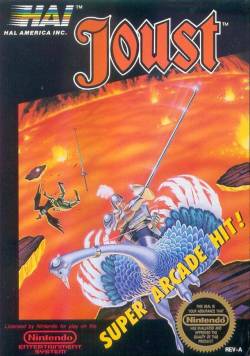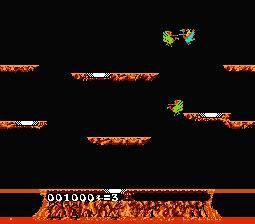 Arcade machines in the 80s were bastards. Later on, I would learn they were built to the two-minute standard. Three lives, just enough to last through two minutes of play, then you’re out and pawing through your Levis for another quarter. But way back then, younger me just knew I’d better have a few week’s worth of allowance on me when the family went out to the frozen yogurt shop. And for good reason.
Arcade machines in the 80s were bastards. Later on, I would learn they were built to the two-minute standard. Three lives, just enough to last through two minutes of play, then you’re out and pawing through your Levis for another quarter. But way back then, younger me just knew I’d better have a few week’s worth of allowance on me when the family went out to the frozen yogurt shop. And for good reason.
That’s where the Joust machine lived.
Lived, perhaps, isn’t the best term. Lurked, waited, hungered, maybe. Crouched in darkness near the back of the store, just off the restroom entrance, it was a sit-down cabinet, the table-top kind, where 1982’s most glorious colours and sounds flickered with temptation beneath a glass top and your vanilla-chocolate swirl. It was wonderful and cruel. You see, back then, a dollar was a week’s allowance, and the two-minute rule said that buck would earn me eight minutes of play. A mere three-hundred and twenty seconds. Not even enough time to lick all the drippies off my frozen yogurt cup.
**** that noise.
I got good. I got real good. Whatever gods watched over the two-minute rule beheld my power and gnashed their teeth in despair. Soon enough, when my parents dragged me from the shop I still had enough change left over for one of those sticky-hand stretchy things from the gumball machine. Then I had enough left over for a soda and an ice cream sandwich to go. Then we moved, and I was Joustless.
The Atari 2600 brought Joust back into my life, but it wasn’t the game I’d known. Blocky, one-colour figures, simple levels, and much, much too easy.
When Joust hit the Nintendo Entertainment System, the console wars were won for me. There was no more discussion to be had.
 So what’s Joust, then? I’ve blown this much of your time being utterly vague because I know most of you reading this were, at best, learning harsh lessons about putting the cat in your mouth and not entirely part of the gaming scene. You wouldn’t know about Joust, so I’ve saved up everything for one go.
So what’s Joust, then? I’ve blown this much of your time being utterly vague because I know most of you reading this were, at best, learning harsh lessons about putting the cat in your mouth and not entirely part of the gaming scene. You wouldn’t know about Joust, so I’ve saved up everything for one go.
Joust is an arcade style game where you take the role of a knight on a flying steed. The steed in question is an ostrich. Your goal is to fly up against other knights on their own winged mounts and “joust” them into egghood with your lance. At the moment of contact, if your lance happened to be higher than your whimpering victim, you’d win and he’d turn into an egg that would fall to earth for you to collect. If his lance was higher, you’d lose and explode in common video game fashion.
As you cleared levels, the ledges that made up the local terrain would crawl away to attend the sort of parties geography throws, leaving you with a larger open space and more enemies filling it. The bad guys came in three different flavours, red, white, and blue, each more skillful than the last. After three levels, the bridges over the lava burned away, and unleashed the lava troll to grab at anything flying over his boiling domain. This could be either a blessing or a curse, as he’d catch and hold Team Evil just as readily as your own fine self.
But there was a final enemy that hungered for your blood and yours alone. The Pterodactyl, a foe with measured patience, would come sweeping in from the sides if your murderous contests broke the clock. But yet, even this menace was not invulnerable, and a well-timed lance would blast him into little more than bonus score.
This was the game, and in 1988, the NES brought back those glorious colours in full bloom. Even the attract mode was there, the despoiled ranks of the evil knights stalking across the screen on their stooped vultures as names and point values appeared to match them. Bounder. Hunter. Shadow Lord. The face of the enemy.
NES Joust was more than just a classic and a piece of my psychic soul returned to me. The graphics were bright, strong, just as crisp and clear as the arcade’s own. The levels were the same, the play so similar. Even the Pterodactyl, swift in his retribution, was there to punish those who would shirk from combat. This was more than just a game, but a revelation that this small box next to the TV, gray and more gray, was the doom of the arcade. No more would the cabinet machines swallow my quarters with drooling lust under the baleful eye of the two-minute rule. With my small box, a new play was now just a Reset button away. This was my first brush with obsolescence, and thus, the first step toward becoming the misanthropic nihilist I am today.
NES Joust made it clear to me that all creatures will die and all things will be broken.
Thinking back on that tabletop demon of wasted quarters in the dim corner of the yogurt shop, this revelation made me smile.
Arcade machines in the 80s were bastards.

Recent Comments